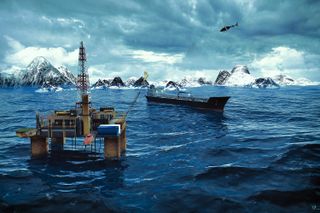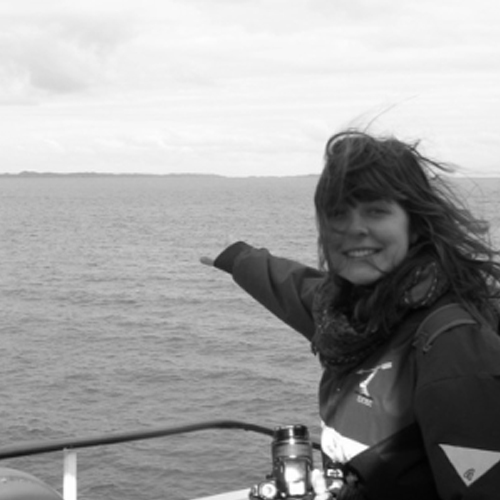
Why Is There So Much Oil in the Arctic?

In 2007, two Russian submarines plunged down 2.5 miles (4 kilometers) into the Arctic Ocean and planted a national flag onto a piece of continental shelf known as the Lomonosov Ridge. Rising from the center of the Arctic Basin, the flag sent a clear message to the surrounding nations: Russia had just laid claim to the vast oil and gas reserves contained in this underwater turf.
Russia's dramatic show of power had no legal weight — but it isn't the only nation that's trying to stake claims to the Arctic's vast depository of oil and gas. The United States, Norway, Sweden, Finland and China are all trying to cash in. It's no wonder: Projections show that the area of land and sea that falls within the Arctic Circle is home to an estimated 90 billion barrels of oil, an incredible 13% of Earth's reserves. It's also estimated to contain almost a quarter of untapped global gas resources.
Most of the oil that's been located in this region so far is on the land, just because it's easier to access. But now, countries are making moves to start extracting offshore, where the vast majority — 84% — of the energy is believed to occur. But long before this oil race began, how did the Arctic become so energy rich? [How Does Oil Form?]
"The first thing you realize [if you look at a map] is that the Arctic — unlike the Antarctic — is an ocean surrounded by continents," Alastair Fraser, a geoscientist from Imperial College London, told Live Science. Firstly, this means there's a huge quantity of organic material available, in the form of dead sea creatures such as plankton and algae, which form the basis of what will ultimately become oil and gas. Secondly, the surrounding ring of continents means that the Arctic Basin contains a high proportion of continental crust, which makes up about 50% of its oceanic area, Fraser explained. That's significant because continental crust — as opposed to ocean crust, which makes up the rest of the area — typically contains deep depressions called basins, into which organic matter sinks, he said.
Here, it gets embedded in shale and preserved in 'anoxic' waters, meaning they contain little oxygen. "Normally, in a shallow sea with lots of oxygen, it would not be preserved. But if the sea is deep enough, the ocean will be stratified, meaning the oxygenated waters at the top will be separated from the anoxic conditions at the base," Fraser explained. Conserved within these oxygen-deprived basins, the matter maintains compounds that ultimately make it useful as an energy source millions of years in the future.

As mountains erode over millennia, the continents also provide a wealth of sediment, transported via huge rivers into the sea. This sediment flows into the basins, where it overlays the organic material, and over time, forms a hard but porous material known as "reservoir rock," Fraser said. Fast-forward millions of years, and this repeated layering process has put the organic material under such immense pressure that it has begun to heat up.
"The temperature of the sediments in basins increases roughly 30 degrees Centigrade [54 degrees Fahrenheit] with every 1 kilometer [0.6 miles] of burial," Fraser said. Under this intensifying pressure and heat, the organic material very gradually transforms into oil, with the highest temperatures forming gas.
Sign up for the Live Science daily newsletter now
Get the world’s most fascinating discoveries delivered straight to your inbox.
Because these substances are buoyant, they begin moving upward into the gaps within the porous sedimentary rock, which becomes like a storage container — the reservoir — from which oil and gas are extracted.
So it's the combination of these ingredients — huge quantities of organic matter, abundant sediment to lock in the oil and gas, the ideal underlying geology and the huge scale across which these occur — which makes the Arctic Ocean so unusually energy rich. (On land, where a smaller percentage of the Arctic's overall oil and gas lies, these reserves were most likely formed in a time when the land was covered by sea.)
Into the wild
However, just because the energy is there doesn't mean it should be extracted, many conservationists and scientists say. The Arctic's remoteness, its dense, moving sea ice and drifting icebergs will make it a huge logistical challenge to safely extract oil and gas. [How Are Oil Spills Cleaned?]
"I really don't support it, because the industry does not have the technology to do it safely and in an environmentally friendly way," Fraser said. "Some people will argue that you never can do it in the Arctic in an environmentally friendly way."
Even on land, plans to expand oil and gas development in the Arctic are treated with concern. This year, the United States government intends to start leasing land in Alaska's Arctic National Wildlife Refuge to energy companies, because the refuge contains a vast, 1.5 million-acre (607,000 hectares) coastal plain that's rich in oil. But, it's also a biodiverse landscape that's home to huge migratory herds of caribou, hundreds of bird species and polar bears. "It's been called America's last great wilderness; it's one of the ecologically richest landscapes in the U.S.," said Garett Rose, an attorney with the Alaska Project at the Natural Resources Defense Council.

It's not just the increased risk of oil spills if drilling goes ahead that's concerning; conservationists also worry about seismic exploration, which "involves running these giant trucks over the landscape to send shock waves into the ground that return information on the underlying geology," Rose told Live Science. That would cause obvious disruption to wildlife. Construction of roads and pipelines will slice up this intact landscape and bring in increasing numbers of people — which will intensify the pressure on wildlife.
"[The refuge] is a dynamic and interconnected landscape that's extremely sensitive to change," Rose said. He also said he was concerned about the U.S. government's recent (but failed) attempt to open the Arctic off Alaska's coast to offshore drilling, too. "This is part of a wholesale attempt to expand oil and gas development across the Arctic," Rose said.
Indeed, the situation in the Alaskan Refuge provides just a taster of what could unfold in other parts of the Arctic, if oil and gas extraction projects forge ahead. The risk of oil spills is enlarged offshore, because they'd be impossible to contain — with untold potential effects on sea life. And some scientists say the greatest ultimate threat is climate change. Bringing these fossil fuels to the surface would only lead to more fuel use, and more emissions being pumped into our atmosphere.
We're not there yet: Countries need to ratify an international United Nations agreement if they want to extract fossil fuels from parts of the continental shelf that fall beyond their offshore jurisdiction. That's slowing the Arctic rush. Still, international pressure is mounting, with countries like Russia having already staked out their claim on the seafloor.
And it could be a hard sell to make countries see that those reserves should remain untapped. In short, said Fraser, "I hope this region doesn't become too important [for energy production]."
- In Photos: A Conveyor Belt for Arctic Sea Ice
- 10 Things You Need to Know about Arctic Sea Ice
- On Ice: Stunning Images of Canadian Arctic
Originally published on Live Science.

Emma Bryce is a London-based freelance journalist who writes primarily about the environment, conservation and climate change. She has written for The Guardian, Wired Magazine, TED Ed, Anthropocene, China Dialogue, and Yale e360 among others, and has masters degree in science, health, and environmental reporting from New York University. Emma has been awarded reporting grants from the European Journalism Centre, and in 2016 received an International Reporting Project fellowship to attend the COP22 climate conference in Morocco.
